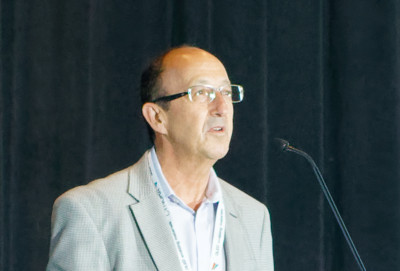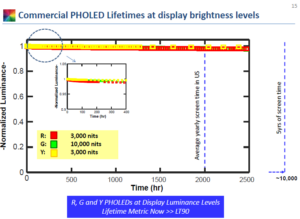 Dr Mike Hack is from UDC and we have reported his talks many times over the years. He started by saying that it has been ‘quite a ride’ in developing the OLED business.
Dr Mike Hack is from UDC and we have reported his talks many times over the years. He started by saying that it has been ‘quite a ride’ in developing the OLED business.
UDC material has been in commercial products for ten years and is made by its partner, PPG. It has red, yellow and green materials at the moment. It has 13 partners in the OLED display supply chain and a bit less than this in lighting. Hack went through a description of the company and the core advantages of OLED. One that he highlighted is the ‘low blue light output’ of OLEDs (a good use of the idea of turning a problem into a feature!).
Hack said that the company is ‘making good progress on blue’ – we’ve heard that before!
He showed how the lifetime of green has radically changed as the firm developed not only the emissive material but also the host material and the interfaces. He also showed how the performance can be very stable over time for the phosphorescent materials (in red, green and yellow, of course).
UDC showed this lifetime chart for its Red, Green and Yellow materials
The next wave of displays is flexible and, as we reported, LG showed a 65″ rollable OLED TV prototype at CES.
Hack said that auto makers are very keen on the controllability and uniformity of OLED taillights, with performance that LED cannot get close enough to.
In TV, there is a lot of interest in RGB architectures and UDC has developed Organic Vapour Jet Printing which allows printing with current materials, without the problems of solvents in other printing approaches.
The company also sees applications in medicine as near infrared can be used to help healing.
Analyst Comment
Maybe OVJP is a solution for deposition of materials, but the blue problem does need to be solved. I know that UDC, as a listed company, has to be very careful about making premature announcements, but I didn’t get the sense that a breakthrough on phosphorescent blue is near. (BR)

